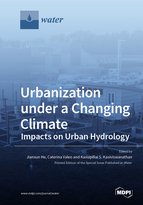Urbanization under a Changing Climate – Impacts on Urban Hydrology
A special issue of Water (ISSN 2073-4441). This special issue belongs to the section "Urban Water Management".
Deadline for manuscript submissions: closed (20 March 2020) | Viewed by 34578
Special Issue Editors
Interests: stormwater management and low impact development; surface water quality assessment and management; hydrological modeling; climate change impacts on water resources; hydrological extremes
Interests: disturbance modeling in forested regions; sustainable urban development of water resources; climate change impacts and analysis using artificial neural networks; pollutant dispersion
Special Issues, Collections and Topics in MDPI journals
Interests: hydrological modelling; stochastic hydrology; uncertainty analysis; reservoir operation
Special Issues, Collections and Topics in MDPI journals
Special Issue Information
Dear Colleagues,
Under the pressure of urbanization, the science of urban hydrology has advanced to improve urban water system management for developing/creating more livable cities, in which public safety and health, as well as the environment, are protected. The ultimate goal of urban water management is to mimic the hydrological cycle prior to urbanization. On top of urbanization, climate change, which has been demonstrated to alter the hydrological cycle in all respects, is further introducing challenges to managing urban water systems. To mitigate and adapt to urbanization under a changing climate, our further understanding of key hydrologic components should be expanded including climate change into consideration; thus, effective and efficient measures can be formulated. Furthermore, urban water management aims to improve system resiliency and sustainability given that the principle of stationarity may be invalid under urbanization and climate change. Therefore, this Special Issue will cover a wide range of topics from fundamental urban hydrology to measures for enhancing urban water management under urbanization and climate change.
The specific topics include, but are not limited to:
- Rainfall measurement, modeling, and forecasting at a finer resolution in both time and space for variability/change assessment and urban hydrological modeling;
- Impacts of urbanization and climate change on hydrologic components including evapotranspiration, surface runoff and subsurface flow;
- Impacts of urbanization and climate change on receiving water bodies with a focus on degradation in water quality (including conventional and emerging pollutants) and ecosystems;
- Hydrological modeling and forecasting, particularly taking into account the impacts of both urbanization and climate change;
- Approaches to managing urban stormwater using infiltration-based techniques (e.g., bioretention systems, permeable pavements, green roofs, etc.) and retention-based techniques (e.g., stormwater ponds, wetlands, etc.) and stormwater reuse;
- Assessment of uncertainty from various sources in hydrological modeling/analysis, especially in a changing climate;
- Urban water infrastructure design (e.g., stormwater drainage system) in a changing climate and/or urbanization;
- Non-stationary hydrology.
Assoc. Prof. Jianxun (Jennifer) He
Prof. Caterina Valeo
Assit. Prof. K.S. Kasiviswanathan
Guest Editors
Manuscript Submission Information
Manuscripts should be submitted online at www.mdpi.com by registering and logging in to this website. Once you are registered, click here to go to the submission form. Manuscripts can be submitted until the deadline. All submissions that pass pre-check are peer-reviewed. Accepted papers will be published continuously in the journal (as soon as accepted) and will be listed together on the special issue website. Research articles, review articles as well as short communications are invited. For planned papers, a title and short abstract (about 100 words) can be sent to the Editorial Office for announcement on this website.
Submitted manuscripts should not have been published previously, nor be under consideration for publication elsewhere (except conference proceedings papers). All manuscripts are thoroughly refereed through a single-blind peer-review process. A guide for authors and other relevant information for submission of manuscripts is available on the Instructions for Authors page. Water is an international peer-reviewed open access semimonthly journal published by MDPI.
Please visit the Instructions for Authors page before submitting a manuscript. The Article Processing Charge (APC) for publication in this open access journal is 2600 CHF (Swiss Francs). Submitted papers should be well formatted and use good English. Authors may use MDPI's English editing service prior to publication or during author revisions.
Keywords
- Urbanization
- Climate change
- Hydrologic cycle
- Hydrologic modeling and forecasting
- Urban water quanity and quality
- Urban water management
- Urban water infrastructure design
- Uncertainty analysis
- Non-stationarity
- Best management practices
- Sustainable urban design








